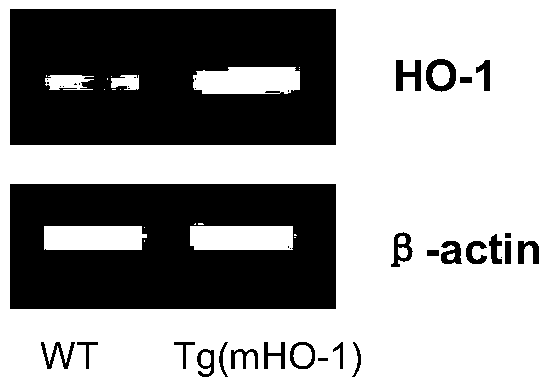Method for generating HO-1/APP/PSEN1 triple-transgenic Alzheimer disease mouse model
A technology of Alzheimer's disease and PSEN1, applied in the field of biotechnology, can solve the problems of not receiving curative effect, not in line with the pathogenesis of AD pathology, etc.
- Summary
- Abstract
- Description
- Claims
- Application Information
AI Technical Summary
Problems solved by technology
Method used
Image
Examples
Embodiment 1
[0052] Embodiment 1: Construction of Tg (mHO-1) transgenic mouse model
[0053] 1. Obtain the target gene:
[0054] Design primers containing EcoRI restriction endonuclease sites to amplify the cDNA sequence of heme oxygenase 1 (hemeoxygenase1(mHO-1), GeneID: 15368) gene in the mouse genome, using EcoRI restriction endonuclease The amplified product was digested, and the digested product was inserted into the EcoRI site of the pCAGG vector to obtain a pCAG recombinant vector containing the cDNA of Hmox1, which was named pCAG-mHO-1. mHO-1 cDNA gene is initiated by chickenβ-actin promoter and CMV enhancer, and mHO-1 is connected with rabbitβ-globinpoly(A) termination signal. The pCAG-mHO-1 plasmid was digested with SalI and DraI to obtain the linear transgene sequence, and the structure diagram of the constructed Tg(mHO-1) mouse transgene fragment is as follows figure 1 Purified recovery was used for microinjection as indicated.
[0055] 2. Produce fertilized eggs of Tg(mHO-1...
Embodiment 2
[0059] Example 2: Generation of Tg(HO-1 / APP / PSEN1) transgenic mice
[0060] Schematic diagram of the method for obtaining Tg(HO-1 / APP / PSEN1) transgenic mice by crossing Figure 5 Shown: the Tg(mHO-1) transgenic mouse constructed in Example 1 was crossed with the APP / PSEN1 double transgenic AD mouse model (Tg(APP / PSEN1), 2TG) to obtain HO-1 / APP / PSEN1 triple transgenic Positive offspring, ie Tg(HO-1 / APP / PSEN1) transgenic mice (3TG). Tg(APP / PSEN1) mice (stocknumber: 004462) were obtained from the National Jackson Animal Center (BarHarbor, ME, USA) and introduced by Nanjing University-Nanjing Institute of Biomedicine.
[0061] The heterozygous progeny was extracted from the mouse tail DNA and screened for the heterozygotes of the three transgenes by PCR. The APP / PSEN1 primers (provided by the National Jackson Animal Center of the United States), and the HO-1 primers are shown in Table 1 below:
[0062] Table 1
[0063]
Embodiment 3
[0064] Example 3: Cognitive function characteristics of Tg(HO-1 / APP / PSEN1) transgenic mice
[0065] The Morris water maze (MorrisR.Developmentofawater-mazeprocedureforstudyingspatiallearningintherat.JNeurosciMethods.1984May; 11(1):47-60.) is a classic experiment for detecting the cognitive function of the hippocampus in Alzheimer's disease, and the Tg(HO- 1 / APP / PSEN1) transgenic mice learning memory and spatial cognition ability. It was verified that the learning and spatial memory abilities of Tg(HO-1 / APP / PSEN1) triple transgenic mice were significantly reduced compared with wild-type mice (WT), and decreased compared with Tg(APP / PSEN1) mice (2TG) more obvious.
[0066] result:
[0067]The detection results of escape latency in the first 5 days of water maze experiment training are as follows: Image 6 As shown, in the water maze experiment, the swimming routes of mice in each group were traced as follows: Figure 7 As shown, the target quadrant distance percentage of the...
PUM
 Login to View More
Login to View More Abstract
Description
Claims
Application Information
 Login to View More
Login to View More - R&D
- Intellectual Property
- Life Sciences
- Materials
- Tech Scout
- Unparalleled Data Quality
- Higher Quality Content
- 60% Fewer Hallucinations
Browse by: Latest US Patents, China's latest patents, Technical Efficacy Thesaurus, Application Domain, Technology Topic, Popular Technical Reports.
© 2025 PatSnap. All rights reserved.Legal|Privacy policy|Modern Slavery Act Transparency Statement|Sitemap|About US| Contact US: help@patsnap.com



